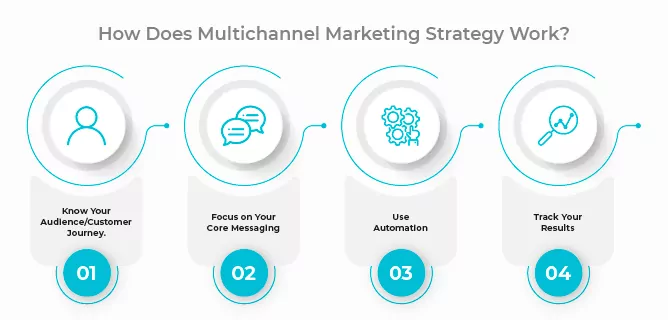Consumers use multiple channels to learn about and connect with brands. You must use more than one channel to market your products or services to potential customers. You need a multichannel marketing campaign. Otherwise, you risk missing out on opportunities to generate sales.
To increase brand awareness and reach more customers, check out the latest trends in multichannel campaigns. First, let’s examine what multichannel marketing is and why you should implement these strategies.
Key Takeaways:
- Multichannel marketing campaigns utilize offline and online methods to reach and engage with their target audience.
- Your brand must implement multichannel marketing strategies to increase brand awareness, reinforce your brand’s message, and gain insights into buying patterns.
- Growing trends in digital marketing campaigns include broadcasting live streams and making interactive videos.
- Recent studies show that promotional marketing events impact purchasing and that 91% of consumers feel more positively toward a brand after an event.
- Chatbots utilize AI and machine learning (ML) to engage with your customers to answer questions, schedule an appointment, and troubleshoot minor issues.
What Is Multichannel Marketing?
Brands use multichannel marketing campaigns through off- and online methods to reach potential customers and engage with leads. Investing in search and social media ads are examples of online channels, while print ads, billboards, and direct-to-home mailers are examples of offline campaigns.
Most consumers don’t shop using only one channel. Approximately 74% of shoppers state they use multiple channels to begin and finalize transactions. Brands report success in various methods, depending on factors like:
- Industry type
- Products vs. goods sold
- Distribution/delivery methods
- Consumer demographics
- Buyer personas
Why You Should Implement a Multichannel Marketing Strategy
A Salesforce study revealed that 56% of buyers expect personalized offers. Multichannel marketing strategies help you create customized offers specific to each customer, but that isn’t the only reason your organization needs to implement multichannel campaigns.

Image: Contentbot
Managing multiple campaigns across various channels is by no means an easy task. Multichannel marketing campaigns require more resources. Other challenges include creating a consistent brand identity, cohesive messaging, and attributing sales to correct channels.
However, when your brand implements multichannel campaigns, the dividends can pay off handsomely. It does this through:
- Increased brand awareness: Customers unfamiliar with your brand have no incentive to purchase your products or services. Marketing across multiple channels increases brand recognition.
- Additional data collection: Multiple channels delivers more opportunities for data collection. These insights provide a more detailed view of your customers’ purchasing habits.
- Reinforcing voice, tone, and messaging: Consistency in brand identity is easier with multichannel marketing campaigns because you can develop guidelines shared across every platform.
- Increased revenue generation: These campaigns generate more revenue. Customers who interact with brands more effectively are more likely to purchase from that brand in the future.
4 Multichannel Marketing Campaigns Trend for 2023
With so many marketing channels to choose from, it can be another challenge to figure out which of the latest marketing trends will pay off the most in the long run.
It all depends on the ROI and how much you spend versus the resulting revenue generated. Let’s review the most cost-effective methods across various channels:
1. Live Streams
There are over 50 million daily TikTok users, with 90% accessing the app daily (or multiple times each day). There are more than twice as many monthly YouTube users as TikTok users. It makes sense why brands use these channels to stream live videos directly to their clients.
These videos have chat features that allow leads or potential customers to interact with a brand representative in real time. That way, consumers can learn about products or services, ask questions, and engage with your organization.
2. Videos
For the same reasons your brand should broadcast live streams, you should also develop, film, and edit videos about your brand and its offerings. Most (69%) people claim they prefer to watch a short video to learn more about a brand.
These videos include:
- How-tos and instructional
- Showcases and product demos
- Customer testimonials
- Industry expert interviews
- Behind-the-scenes and blooper shorts
While TikTok and YouTube are the two social media giants focusing on creating video content, Facebook and Instagram Reels and Stories are other great ways to post videos. You can also post shorter videos on Snapchat and Twitter.
3. Events
Do you remember the last time M&M’s ran a promotional event to help them decide on a new flavor? The brand developed an immersive “flavor room” where visitors walked around sampling the various flavors and then voted on the winner.
It was a big hit among consumers, and before the brand launched the new flavor, sales for the quarter were already up. Why?

Source: Sendpulse
Simple. Consumers want an immersive experience with a brand. Eighty-five percent of consumers are likely to purchase after participating in a sales event. Almost everyone (91%) who attends brand events leaves with a more positive feeling about that brand.
Not every brand can offer an immersive experience like M&M’s did. Brainstorm with your team to see who can come up with a creative event idea.
4. Chatbots
If your organization is not utilizing chatbots on their website or engagement platform, stop what you are doing and get one (feel free to finish reading first).
Using an enterprise content management system that employs AI to generate content created by chatbots is an excellent way for customers to answer questions, schedule appointments, and troubleshoot minor issues.
Discover Which Multichannel Marketing Campaign Performs Best
Multichannel marketing strategies are a necessary part of brand promotion. Customers today use various channels to research and purchase goods and services.
Brands need a strategy established to meet potential customers across their preferred channels of communication. Create social media posts, send SMS texts, mail print ads, and respond to engagements.
At MXTR, our marketing automation platform can track your leads across multiple channels. Gain insights into how your customers engage most with your brand so that you can focus your marketing efforts on proven strategies. We can create a custom model you can use to measure your results.
Request a demo to learn more about MXTR marketing automation and how it tracks multichannel marketing campaigns.
Featured Image: istockphoto







